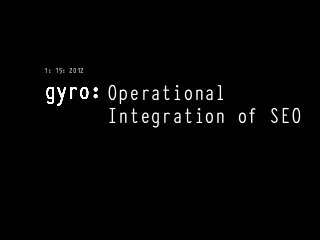
Best Practices: Integrating SEO Into Your Business
- 1. 1: 15: 2012 Operational Integration of SEO
- 2. What is SEO? • Using search data to build an effective content & product strategy • Using search engines to connect with audiences and delight them • Using the right data to measure, adjust and improve business outcomes
- 3. Understanding Search Engines • Search engines are trying to return the “best” set of documents for a given query • How do search engines measure “best”? – Relevance (On-Page SEO) • Presence of machine-readable text containing keywords related to the user’s query • Having that text appear in “important” places on the page • Using complex machine learning to rate content quality (Google’s Panda algorithm) – Authority (Off-Page SEO) • Evaluating the web’s link graph, social mentions and author data as “votes” for documents
- 4. 3 Pillars of On-Page SEO 1. Information architecture - Has a major impact on how link authority flows to URLs - Technical factors influencing crawlability / findability 2. Code - Coding decisions influence engines’ ability to “understand” pages (AJAX, Flash, etc) - Proper use of semantic HTML (title tags, meta descriptions) 3. Content - Keyword targeting - Audience journey - Quality and uniqueness
- 5. SEO Deliverables - IA 1. Information architecture - IA analysis and optimization • Based on a crawl of the site or internal IA review - URL structure • Short, static, descriptive - Canonicalization • 301 redirect mapping • Canonical link element - Error handling and HTTP status codes - Robots management - XML sitemaps • Content segmentation to allow iterative optimization • Multi-lingual content
- 6. SEO 1. IA Deliverables - Code 2. Code - Wireframe review • Balance visual design, creativity and interactivity with search engines’ technical requirements - Define SEO requirements for each page template • Semantic HTML for each URL • Ensure web development patterns are rendering pages that render machine-readable text that can be crawled and indexed by engines • Work with developers on code-level implementation questions - Authorship • Incorporate authorship signals for trust, ranking and CTR - Rich snippets • Title or professional role, affiliation, address, etc - Web performance
- 7. SEO Deliverables - Content 1. 2. Information architectu Code 3. Content - Keyword targeting • Keyword research, analysis and taxonomy - Audience journey aligned with query intent to improve UX • Awareness • Consideration • Demand generation - Quality and uniqueness • Content sourcing decisions (unique vs licensed, etc) • Subjective content quality o Google’s Panda algorithm allows a machine-learning approximation of whether content is “low quality” or not o Above a certain threshold, all content is demoted in rankings
- 8. SEO and Product Management • Project initiation – Audit of product-level performance on the site • Determine where products have opportunities for improvement – Identify and add SEO requirements for each product to the PRD • During development – Work with developers to address questions around SEO requirements in the PRD – Work with QA to create automated SEO-specific tests for launch • Post launch and ongoing – Use data from web & SEO analytics to track product performance – Identify iterative optimization opportunities to improve product performance and yield
- 9. SEO and UX / UI • Project initiation – Information architecture creation • Conceptual organization • Findability – Wireframe development • Balance visual design, creativity and interactivity with search engines’ technical requirements • During development – Crawl site on staging server to uncover issues with findability • Post launch and ongoing – Use web and SEO analytics data to iteratively improve IA – Use 3rd party tools to improve user experience & business outcomes
- 10. SEO and Developers • Project initiation – Ensure developers understand SEO requirements • 90+ SEO-specific tests in gyro’s Developers’ SEO Checklist • Project-specific requirements • During development – Work with developers directly to address implementation questions • Provide code-level examples – Perform technical audits at key development milestones • Post launch and ongoing – Technical crawl of the site to identify bugs – Support developers during iterative product and site optimization
- 11. SEO and CRM • Project initiation – Identify opportunities to engage with customers • Lead capture • Customer feedback, contact us, etc – Assist with business requirements for CRM integration • Progressive data capture for different conversion events – Align expressed user intent with value delivered • User intent Value proposition Data capture • During development – Work with QA to create tests for data capture, routing & handling • Post launch and ongoing – Use data from web & SEO analytics to improve conversion rate
- 12. SEO & Content Creation • Project initiation – Content audit • Assess performance of current content toward defined business outcomes • Gap analysis and competitive content audits • Keyword opportunities • During development – Test crawlability and rendering of content • Ensure correct implementation of semantic HTML • Post launch and ongoing – Content strategy and content marketing • Align market need with company’s core competencies • Systematize content creation and promotion toward specific outcomes
- 13. SEO and Social Media • Project initiation – Social listening – Competitive landscape assessment – Content audit • Search and social media performance indicators – Set objectives for content marketing success • During development – Define your strategy • Post launch and ongoing – Listen – Measure – Create and iterate
- 14. THANK YOU!
Editor's Notes
- Search has touchpoints with each of these groups throughout the entire projectReflective of our approach as an integrated agencySearch interacts with and informs the work of all these groupsSearch is NOT an add-onStrategic vs tactical valueSearch’s job is to act as an advocate on behalf of the search enginesEngines are an audience with specific technical requirementsYou have to build the site with an understanding of what search engines can and cannot do
- URL structure, canonicalization
- URL structure, canonicalization
- URL structure, canonicalization
